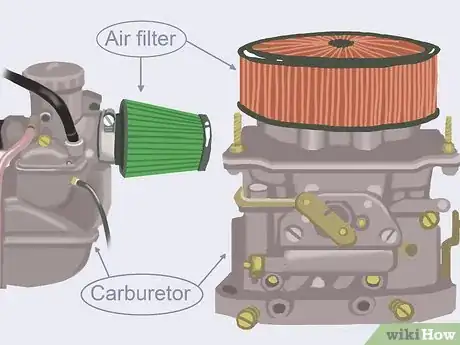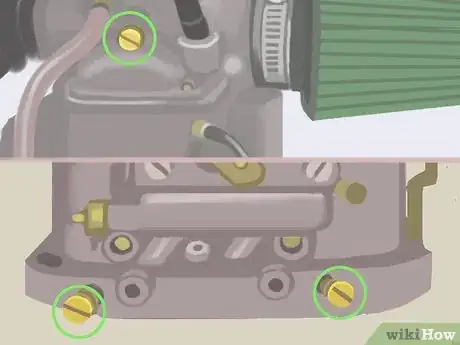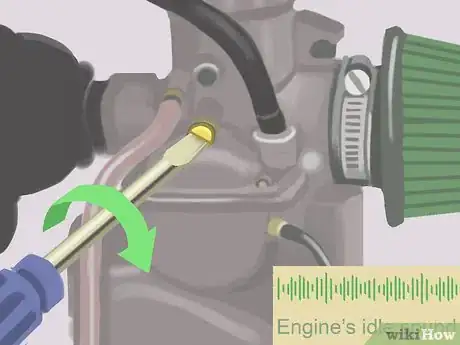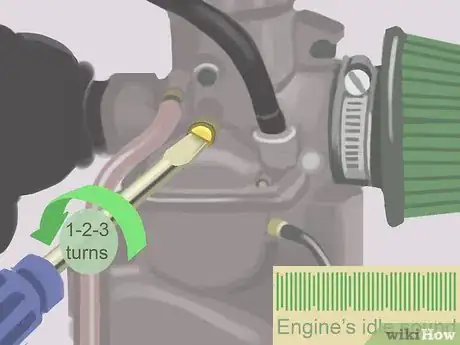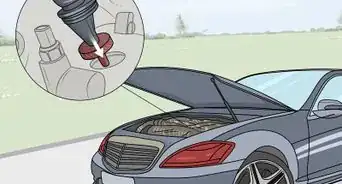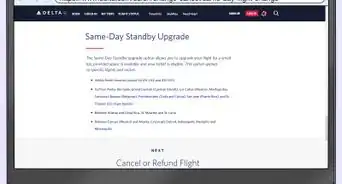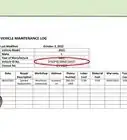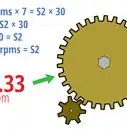This article was co-authored by Hovig Manouchekian. Hovig Manouchekian is an Auto Repair and Design Specialist and the Manager of Funk Brothers Auto, a family-owned business operated since 1925. With over 30 years of experience in the automotive industry, Hovig specializes in the process of auto repair and maintenance. He is also very knowledgeable in common automotive issues and needs including engine repair, battery replacement, and windshield accessory and maintenance. Hovig's knowledge and hard work have contributed to Funk Brothers Auto winning Angie's List Super Service Award for five consecutive years.
wikiHow marks an article as reader-approved once it receives enough positive feedback. In this case, 90% of readers who voted found the article helpful, earning it our reader-approved status.
This article has been viewed 391,449 times.
An air fuel mixture screw is a special screw on an engine’s carburetor that controls how much air mixes with the fuel. Adjusting this screw changes how fast or slow an engine idles and how smoothly it runs. The basic process for adjusting an air fuel mixture screw is the same for all small engines, whether it’s on a car, motorcycle, or other type of engine. Make adjustments with the engine warmed up and running. Set the screw in the position where the engine idles most smoothly and doesn’t sound rough or irregular to balance the fuel mixture so that the engine has an ideal air fuel ratio.
Steps
Accessing the Air Fuel Mixture Screw
-
1Start the engine and let it run for 5 minutes to warm it up. Turn the key in the ignition to start the engine. Warm up the engine to normal operating temperature by letting it idle for about 5 minutes. Keep the engine running after it warms up.[1]
- Always make air fuel mixture screw adjustments with a warm engine and the engine running, so you can listen to how the adjustments affect the engine’s idle speed.
- Note that this process is the same for any type of engine with an air fuel mixture screw. It could be a car, motorcycle, scooter, ATV, or anything else with a carburetor.
Tip: An air fuel mixture screw is also known as an idle mixture screw.[2]
-
2Locate the carburetor by finding the engine’s air filter. Look at the engine and spot the round or cone-shaped air filter. The carburetor is the part of the engine that the air filter is attached to.[3]
- The air filter on a car might be large and round. It usually sits on top of the carburetor.
- On a motorcycle, the air filter usually comes off the side of the engine and faces the rear of the bike.
Advertisement -
3Find the flat-headed, slotted, gold-colored brass screw on the carburetor. Look at all the different screws on the carburetor until you spot the gold one with a flat slotted head. This is the air fuel mixture screw.[4]
- Most air fuel mixture screws are located on the side of the carburetor, but it depends on the specific engine.
Balancing the Fuel Mixture
-
1Turn the screw clockwise until the engine starts to sound rough. Use a flathead screwdriver to tighten the screw. Listen to the engine’s idle sound and stop turning the screw when it starts making a rough rising and falling sound instead of its normal idling sound.[5]
- Tightening the screw weakens the air and fuel mixture and decreases the amount of fuel flowing to the engine.
- Tightening the screw is also called making the fuel mixture leaner, which lowers the RPMs at which the engine idles.
- Running a lean fuel mixture makes the engine run with less fuel than it needs to run efficiently. This can damage an engine because there is more friction between moving parts and the engine operates at a higher temperature.
-
2Loosen the screw and count the turns until the engine sounds irregular. Use your flathead screwdriver to turn the screw counterclockwise, counting the number of rotations you make as you go. Listen to the idling of the engine and stop turning the screw when the engine’s idle sound starts sounding irregular, like it is revving too fast.[6]
- Loosening the screw strengthens the air and fuel mixture and increases the amount of fuel flowing to the engine.
- Loosening the screw is also called making the fuel mixture richer, which increases the RPMs at which the engine idles.
- Running a rich fuel mixture causes the engine to run with more fuel than it needs to operate efficiently. This means that it will burn fuel much faster than necessary, although the engine may run with more power and at a cooler temperature.
-
3Set the screw in the middle between the rough- and irregular-sounding spots. Turn the screw back clockwise until it is approximately in the middle location between where the engine’s idle sounds irregular and rough. This will set the engine at a regular idle speed.[7]
- For example, if you turned the screw 2 full turns counterclockwise from the spot where the engine’s idle started to sound rough, now turn the screw clockwise 1 full turn.
-
4Make adjustments 1/2 a turn in either direction to find the smoothest idle speed. Turn the screw counterclockwise and clockwise 1/2 a turn from the middle position and listen to the sound of the idle. Set the screw in the position where the engine’s idle sounds most even and smooth to balance the fuel mixture.[8]
- You might notice that turning the screw 1/2 a turn in either direction makes the engine start to sound rougher or more irregular, in which case you can just set the screw back to the middle position.
- This adjustment process is also known as balancing the idle mixture.
- Most engines have an ideal air fuel ratio, or AFR, around 14.7:1. You could find your engine’s exact AFR using a special meter, but this isn’t really necessary unless you want to be ultra-precise, such as if you’re tuning a high-performance race car or motorcycle.[10]
Tip: The factory position for most air fuel mixture screws is usually between 1.5 and 2.5 turns out from being screwed all the way in. If you ever want to start fresh, turn the screw clockwise until it is lightly seated, then back it out about 2 turns. Then you can make adjustments from this position.[9]
Expert Q&A
-
QuestionHow do I check the air-fuel mixture if my vehicle doesn't have a carburetor?
 Hovig ManouchekianHovig Manouchekian is an Auto Repair and Design Specialist and the Manager of Funk Brothers Auto, a family-owned business operated since 1925. With over 30 years of experience in the automotive industry, Hovig specializes in the process of auto repair and maintenance. He is also very knowledgeable in common automotive issues and needs including engine repair, battery replacement, and windshield accessory and maintenance. Hovig's knowledge and hard work have contributed to Funk Brothers Auto winning Angie's List Super Service Award for five consecutive years.
Hovig ManouchekianHovig Manouchekian is an Auto Repair and Design Specialist and the Manager of Funk Brothers Auto, a family-owned business operated since 1925. With over 30 years of experience in the automotive industry, Hovig specializes in the process of auto repair and maintenance. He is also very knowledgeable in common automotive issues and needs including engine repair, battery replacement, and windshield accessory and maintenance. Hovig's knowledge and hard work have contributed to Funk Brothers Auto winning Angie's List Super Service Award for five consecutive years.
Auto Repair & Design Specialist On a modern-day vehicle, air-fuel mixture adjustment is controlled by the computer of the vehicle. Use a scanner to get an air-fuel mixture reading, and you can also use a five-gas analyzer, which is used in emission testing.
On a modern-day vehicle, air-fuel mixture adjustment is controlled by the computer of the vehicle. Use a scanner to get an air-fuel mixture reading, and you can also use a five-gas analyzer, which is used in emission testing. -
QuestionWhat's the problem when I have to pull the outboard so many times before it starts?
 Eddmoore99Community AnswerUsually this indicates a lack of fuel. Priming an engine is necessary if it has been sitting in storage for any length of time. The fuel evaporates and this causes the engine to not start when compression is achieved.
Eddmoore99Community AnswerUsually this indicates a lack of fuel. Priming an engine is necessary if it has been sitting in storage for any length of time. The fuel evaporates and this causes the engine to not start when compression is achieved. -
QuestionTwo-stroke engine fires once, then won't fire. how many turns out should the mixer screw be out?
 Eddmoore99Community AnswerOn the majority of engines that are normally aspirated, a common rule of thumb is to tighten the adjusting screw all the way in and then back it out two full turns. This usually get you to the center of the adjustment range. From there it is much easier to make the fine tuning once the engine has started and been warmed to operating temperature.
Eddmoore99Community AnswerOn the majority of engines that are normally aspirated, a common rule of thumb is to tighten the adjusting screw all the way in and then back it out two full turns. This usually get you to the center of the adjustment range. From there it is much easier to make the fine tuning once the engine has started and been warmed to operating temperature.
Things You’ll Need
- Flathead screwdriver
References
- ↑ https://www.howacarworks.com/fuel-systems/adjusting-a-fixed-jet-carburettor
- ↑ https://www.popularmechanics.com/cars/how-to/a113/1272536/
- ↑ https://www.explainthatstuff.com/how-carburetors-work.html
- ↑ https://www.youtube.com/watch?v=zm5mB3R8Ucw&feature=youtu.be&t=90
- ↑ https://www.howacarworks.com/fuel-systems/adjusting-a-fixed-jet-carburettor
- ↑ https://www.howacarworks.com/fuel-systems/adjusting-a-fixed-jet-carburettor
- ↑ https://www.howacarworks.com/fuel-systems/adjusting-a-fixed-jet-carburettor
- ↑ https://www.popularmechanics.com/cars/how-to/a113/1272536/
- ↑ https://www.youtube.com/watch?v=zm5mB3R8Ucw&feature=youtu.be&t=135

